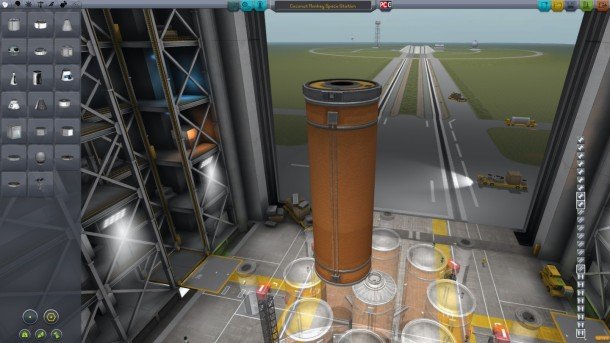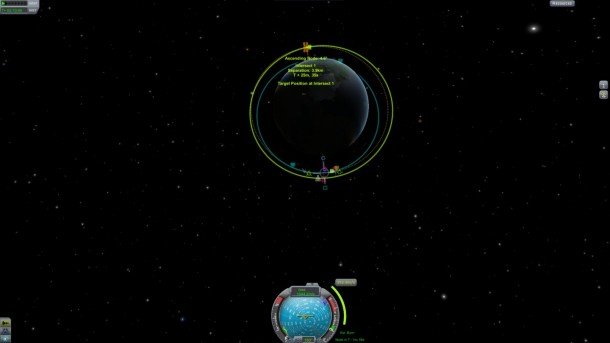Kerbal Space Program chronicle, part three — Coconut Monkey presents Fuel Trader

I head back to the Vehicle Assembly Bay. The construction teams tear off the space station portion of the CMSS plans and reattach a giant fuel tank in its place. They throw on some solar panels, a remote control hub and a docking port, then leave early for the pub. It may be a crucial piece of our plan for a Mün landing, but a complicated design it is not. It's a metal can full of rocket fuel.
Now comes the part of the mission I've been dreading: docking. Orbital rendezvous and docking are incredibly tense procedures, and the margin for error is minimal. Go a little too fast, a little too high, and fuel gets wasted, objects get lots in orbit and, sometimes, everything explodes.
Someone has written on a chalkboard, Objects in higher orbits will circle a planet slower than objects in lower orbits . Got it. In order to make my station and my fuel tank meet, I need them at different orbits. Bringing them to the same orbit would make them stay the same distance from each other, circling forever.

I launch the unmanned fuel tank to an orbit about 20% lower than CMSS, then watch as the two ships circle Kerbin and gradually get closer to each other. When they're pretty close, I open a maneuver node and start fiddling with dials.
The maneuver nodes are programs in the flight computer that let me plan changes to orbit speed, inclination and attitude. When I've got it lined up just right and the computer thinks we'll have a pretty close intersection, I approve the node and line up. When the node arrives, I just point at the target and burn engines until the computer tells me to stop.

Success! I'm now on track for a nice, close intercept of 3.9 kilometers. As mission control watches the two craft orbit the planet, the intersection gets closer and closer. When they're as close as they'll ever get, I point the engines against orbit and burn until our relative velocities match perfectly, giving the illusion of motionlessness. Both ships are still tearing around Kerbin at thousands of meters per second, of course, but compared to each other, they're standing still. It's in this relative-velocity neighborhood that orbital maneuvers can take place.
Keep up to date with the most important stories and the best deals, as picked by the PC Gamer team.

